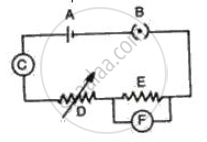Advertisements
Advertisements
Question
An electronics hobbyist is building a radio which requires 150 Ω in her circuit, but she has only 220 Ω, 79 Ω, and 92 Ω resistors available. How can she connect the available resistors to get the desired value of resistance?
Solution
Available resistances = 220 Ω, 79 Ω 92 Ω
Case I:
If 3 resistors are connected in series, then
RS = R1 + R2 + R3 = 220 + 79 + 92 = 391
This value is greater than the required resistance so it is not possible.
Case II:
If 3 resistors are connected in parallel, then
`1/"R"_"p" = 1/"R"_1 + 1/"R"_2 + 1/"R"_3`
`1/"R"_"p" = 1/220 + 1/79 + 1/92` = 0.0279
Rp = 35.84 This does not meet the requirement.
Case III:
If R1 and R2 are connected in parallel and R3 in series
`1/"R"_"p" = 1/"R"_1 + 1/"R"_2 = 1/220 + 1/79 = 0.0172`
`=> "R"_"p" = 58.14 Omega`
This meets the requirement.
APPEARS IN
RELATED QUESTIONS
If the potential difference across the ends of a conductor is 220 V and the resistance of the conductor is 44 Ω (ohm), then the current flowing through is _________.
- 0.2 A
- 0.5 A
- 2 A
- 5 A
What will be the change in the current if the potential difference is kept constant and the resistance of the circuit is made four times?
- It will remain unchanged.
- It will become four times.
- It will become one-fourth.
- It will become half.
Let the resistance of an electrical component remains constant while the potential difference across the two ends of the component decreases to half of its former value. What change will occur in the current through it?
What is an Ohmic resistor?
Name the unit of electrical resistance and give its symbol.
How much energy is consumed when a current of 5 amperes flows through the filament (or element) of a heater having resistance of 100 ohms for two hours? Express it in joules.
Calculate the electric field in a copper wire of cross-sectional area 2.0 mm2 carrying a current of 1 A.
The resistivity of copper = 1.7 × 10–8 Ω m
Fig. represents the circuit used for the verification of ohm's law. Label the different parts from A and F. State the function of each.

Tick(✓) the correct choice in the following:
Ohm's law is applicable to
State macroscopic form of Ohm’s law.
